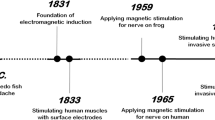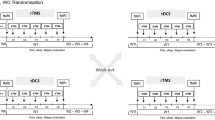Abstract
Given pharmacological interventions’ limited efficacy and abundance of its adverse effects, the repetitive transcranial magnetic stimulation (rTMS) is considered a viable non-invasive option for managing chronic neuropathic pain of different origins with promising outcomes.
Purpose of Review
The provision of a systematic review of current literature on rTMS for managing chronic neuropathic pain of different origins, and assess its efficacy and outcomes, highlighting the need for standard protocols for utilizing rTMS.
Recent Findings
Variable stimulation modalities were trialed targeting the M1, DLPFC, and somatosensory cortices S1 and S2. The M1 yielded the best results in 11 of the studies. Frequency of stimulation was variable; however, optimal outcome was with higher frequencies ranging 10–20 Hz rather than low-frequency 1 Hz.
Summary
Repetitive TMS can produce significant relief from chronic neuropathic pain. The lack of standard methods for rTMS, stimulatory parameters, and target stimulation site precludes concluding the optimal modality for stimulation. The practical algorithm by Lefaucheur and Nguyen (Neurophysiol Clin. 49(4):301–7, 2019) can guide setting standardized algorithms for rTMS. Defining optimal stimulation sites, frequencies, and pulses to maximize patient’s pain relief and minimize required rTMS sessions requires further research.
Similar content being viewed by others

References
Papers of particular interest, published recently, have been highlighted as: •• Of major importance
Vogel S. NICE clinical guidelines. Low back pain: the early management of persistent non-specific back pain. Int J Osteopath Med. 2009;12(4):113–4.
Fayaz A, Croft P, Langford RM, Donaldson LJ, Jones GT. Prevalence of chronic pain in the UK: a systematic review and meta-analysis of population studies. BMJ Open. 2016;6(6):e010364.
Loeser JD, Treede RD. The Kyoto Protocol of IASP basic pain Terminology☆. Pain. 2008;137(3):473–7.
Treede RD, Rief W, Barke A, Aziz Q, Bennett MI, Benoliel R, et al. Chronic pain as a symptom or a disease: the IASP Classification of Chronic Pain for the International Classification of Diseases (ICD-11). Pain. 2019;160(1):19–27.
Institute of Medicine. Relieving pain in America: a blueprint for transforming prevention, care, education, and research. Washington, DC: The National Academies Press; 2011. https://doi.org/10.17226/13172.
Nicholas M, Vlaeyen JW, Rief W, Barke A, Aziz Q, Benoliel R, et al. The IASP classification of chronic pain for ICD-11: chronic primary pain. Pain. 2019;160(1):28–37.
Malavera A, Silva FA, Fregni F, Carrillo S, Garcia RG. Repetitive transcranial magnetic stimulation for phantom limb pain in land mine victims: a double-blinded, randomized, sham-controlled trial. J Pain. 2016;17(8):911–8.
Rossini PM, Burke D, Chen R, Cohen LG, Daskalakis Z, Di Iorio R, et al. Non-invasive electrical and magnetic stimulation of the brain, spinal cord, roots, and peripheral nerves: basic principles and procedures for routine clinical and research application. An updated report from an IFCN Committee. Clin Neurophysiol. 2015;126(6):1071–107.
Legrain V, Iannetti GD, Plaghki L, Mouraux A. The pain matrix reloaded: a salience detection system for the body. Prog Neurobiol. 2011;93(1):111–24.
Sacco P, Prior M, Poole H, Nurmikko T. Repetitive transcranial magnetic stimulation over primary motor vs non-motor cortical targets; effects on experimental hyperalgesia in healthy subjects. BMC Neurol. 2014;14(1):166.
Hosomi K, Sugiyama K, Nakamura Y, Shimokawa T, Oshino S, Goto Y, et al. A randomized controlled trial of 5 daily sessions and continuous trial of 4 weekly sessions of repetitive transcranial magnetic stimulation for neuropathic pain. Pain. 2020;161(2):351–60.
Sun X, Long H, Zhao C, Duan Q, Zhu H, Chen C, et al. Analgesia-enhancing effects of repetitive transcranial magnetic stimulation on neuropathic pain after spinal cord injury: an fNIRS study. Restor Neurol Neurosci. 2019;37(5):497–507.
Cervigni M, Onesti E, Ceccanti M, Gori MC, Tartaglia G, Campagna G, et al. Repetitive transcranial magnetic stimulation for chronic neuropathic pain in patients with bladder pain syndrome/interstitial cystitis. Neurourol Urodyn. 2018;37(8):2678–87.
Nardone R, Hoeller Y, Langthaler PB, Lochner P, Golaszewski S, Schwenker K, et al. rTMS of the prefrontal cortex has analgesic effects on neuropathic pain in subjects with spinal cord injury. Spinal Cord. 2017;55(1):20–5.
Nurmikko T, MacIver K, Bresnahan R, Hird E, Nelson A, Sacco P. Motor cortex reorganization and repetitive transcranial magnetic stimulation for pain—a methodological study. Neuromodulation. 2016;19(7):669–78.
Lindholm P, Lamusuo S, Taiminen T, Pesonen U, Lahti A, Virtanen A, et al. Right secondary somatosensory cortex—a promising novel target for the treatment of drug-resistant neuropathic orofacial pain with repetitive transcranial magnetic stimulation. Pain. 2015;156(7):1276–83.
Khedr EM, Kotb HI, Mostafa MG, Mohamad MF, Amr SA, Ahmed MA, et al. Repetitive transcranial magnetic stimulation in neuropathic pain secondary to malignancy: a randomized clinical trial. Eur J Pain. 2015;19(4):519–27.
Yılmaz B, Kesikburun S, Yaşar E, Tan AK. The effect of repetitive transcranial magnetic stimulation on refractory neuropathic pain in spinal cord injury. J Spinal Cord Med. 2014;37(4):397–400.
Jetté F, Côté I, Meziane HB, Mercier C. Effect of single-session repetitive transcranial magnetic stimulation applied over the hand versus leg motor area on pain after spinal cord injury. Neurorehabil Neural Repair. 2013;27(7):636–43.
Ahmed MA, Mohamed SA, Sayed D. Long-term antalgic effects of repetitive transcranial magnetic stimulation of motor cortex and serum beta-endorphin in patients with phantom pain. Neurol Res. 2011;33(9):953–8.
Peyron R. Long-interval rTMS for long-lasting treatment in neuropathic pain. Brain Stimul. 2019;12(2):576.
Fregni F, Potvin K, DaSilva D, Wang X, Lenkinski RE, Freedman SD, et al. Clinical effects and brain metabolic correlates in non-invasive cortical neuromodulation for visceral pain. Eur J Pain. 2011;15(1):53–60.
Avery DH, Holtzheimer PE III, Fawaz W, Russo J, Neumaier J, Dunner DL, et al. Transcranial magnetic stimulation reduces pain in patients with major depression: a sham-controlled study. J Nerv Ment Dis. 2007;195(5):378–81.
Shimizu T, Hosomi K, Maruo T, Goto Y, Yokoe M, Kageyama Y, et al. Efficacy of deep rTMS for neuropathic pain in the lower limb: a randomized, double-blind crossover trial of an H-coil and figure-8 coil. J Neurosurg. 2017;127(5):1172–80.
Moisset X, Lefaucheur JP. Non pharmacological treatment for neuropathic pain: Invasive and non-invasive cortical stimulation. Rev Neurol. 2019;175(1-2):51–8 This study compares different non-pharmacological interventions for cortical stimulation and highlights the efficacy of non-invasive rTMS.
Migita K, Uozumi T, Arita K, Monden S. Transcranial magnetic coil stimulation of motor cortex in patients with central pain. Neurosurgery. 1995;36(5):1037–40.
Andre-Obadia N, Magnin M, Simon E, Garcia-Larrea L. Somatotopic effects of rTMS in neuropathic pain? A comparison between stimulation over hand and face motor areas. Eur J Pain. 2018;22(4):707–15 This study concludes that the stimulation area depends on cognitive and affective appraisal of pain, rather than on a sensory effect related to the specific motor area stimulated, after comparing stimulation of hand and face motor areas.
O’Connell NE, Marston L, Spencer S, De Souza LH, Wand BM. Non-invasive brain stimulation techniques for chronic pain. Cochrane Database Syst Rev. 2018;4(4):CD008208. https://doi.org/10.1002/14651858.CD008208.pub5.
Hsu JH, Daskalakis ZJ, Blumberger DM. An update on repetitive transcranial magnetic stimulation for the treatment of co-morbid pain and depressive symptoms. Curr Pain Headache Rep. 2018;22(7):51.
Lefaucheur JP, Nguyen JP. A practical algorithm for using rTMS to treat patients with chronic pain. Neurophysiol Clin. 2019;49(4):301–7 This study introduced a practical algorithm for rTMS setting parameters for site, frequency, and duration of stimulation.
Author information
Authors and Affiliations
Corresponding author
Ethics declarations
Conflict of Interest
In compliance with the ICMJE uniform disclosure form, all authors declare the following: Payment/services info: All authors have declared that no financial support was received from any organization for the submitted work. Financial relationships: All authors have declared that they have no financial relationships at present or within the previous 3 years with any organizations that might have an interest in the submitted work. Other relationships: All authors have declared that there are no other relationships or activities that could appear to have influenced the submitted work.
Human and Animal Rights and Informed Consent
This article does not contain any studies with human or animal subjects performed by any of the authors.
Additional information
Publisher’s Note
Springer Nature remains neutral with regard to jurisdictional claims in published maps and institutional affiliations.
This article is part of the Topical Collection on Neuromodulation
Rights and permissions
About this article
Cite this article
Attia, M., McCarthy, D. & Abdelghani, M. Repetitive Transcranial Magnetic Stimulation for Treating Chronic Neuropathic Pain: a Systematic Review. Curr Pain Headache Rep 25, 48 (2021). https://doi.org/10.1007/s11916-021-00960-5
Accepted:
Published:
DOI: https://doi.org/10.1007/s11916-021-00960-5



